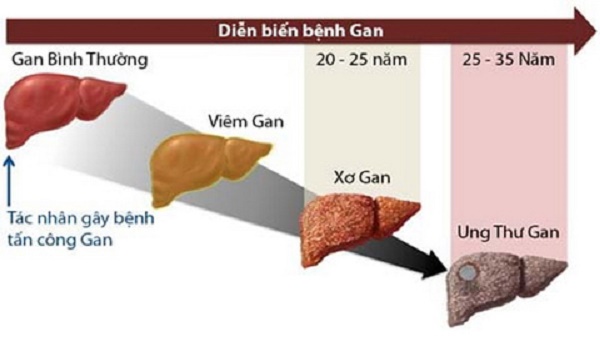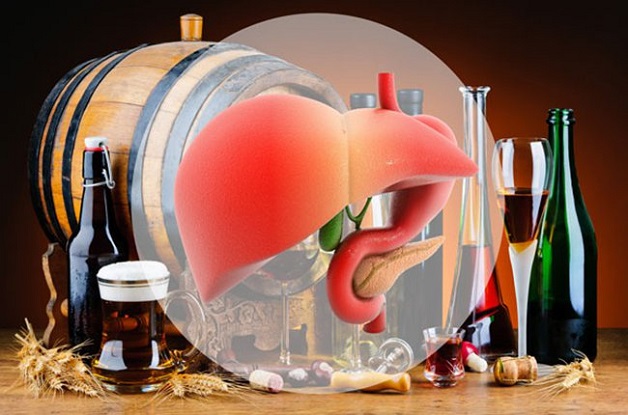Alcoholic cirrhosis is chronic and irreversible liver damage caused by alcohol. This is the most serious complication of liver disease associated with alcohol use. According to research, up to 10-20% of heavy drinkers develop cirrhosis of the liver.
This condition is part of the development of liver disease, which can start with fatty liver disease, then progress to alcoholic hepatitis, and finally to alcoholic cirrhosis. However, there are also many cases where a person can have cirrhosis, but has never faced alcoholic hepatitis before.
1. Symptoms of alcoholic cirrhosis
When drinking too much alcohol, the body will not be able to provide enough enzymes to metabolize. Then the toxic substances will not be able to eliminate and remain in the liver. This amount of toxins gradually destroys liver cells and reduces liver function.
In the early stages of alcoholic cirrhosis, the healthy cells will work more to compensate, so the patient does not have obvious symptoms. However, the condition recurs for a long time, the healthy cells are no longer able to compensate, the damage also gradually spreads around. At that time, the disease became serious and faced many difficulties in treatment.

Process of alcoholic cirrhosis.
Therefore, almost all patients in the early stages of cirrhosis often have no symptoms, later the disease progresses, symptoms appear in patients such as:
– Body itching, discomfort;
– Yellowing of the eyes and skin due to the accumulation of bilirubin in the blood;
– Patients often have anorexia, fatigue, loss of appetite;
– Possible nausea and vomiting;
– Liver function is severely damaged, reducing the activity of synthesizing blood coagulation, so bruises are easily detected on the skin.
However, depending on the patient, the symptoms of alcoholic cirrhosis are also different. Some patients only have fatigue, poor appetite, jaundice, but some people have symptoms of edema, cirrhosis of the liver, ascites, sexual dysfunction… More severe symptoms of complications such as vomiting blood and bowel movements. Black stools due to ruptured esophageal varices, hepatic coma, kidney failure, signs of infection or cirrhosis of the liver, cancer…
In fact, in the past, alcoholic cirrhosis was common in old people, now the age is getting younger. In the emergency department, there are patients who are only nearly 50 years old who are admitted to the hospital with cirrhosis of the liver.
Worryingly, cirrhosis of the liver cannot be completely cured but only treated symptoms, because the liver has cirrhosis, no longer effective in filtering and detoxifying the body. Only after a liver transplant can the disease be completely cured. Therefore, if there are signs of increased liver enzymes, fatty liver, but still maintain the habit of living, drinking a lot of alcohol, eating a lot of fatty foods, and having a lot of animal organs, this risk will increase, gradually leading to hepatitis, cirrhosis because of alcohol.

Alcohol affects liver health, reducing quality of life
2. Diagnosis of alcoholic cirrhosis
To diagnose alcoholic cirrhosis, doctors will first take a history, use status as well as frequency of alcohol use.
Doctors will then order tests to confirm the diagnosis of alcoholic cirrhosis. Tests that may be ordered include: CT scan or MRI scan, liver ultrasound: these techniques provide detailed pictures of the state of the liver, checking to see if liver damage has progressed to where.
Blood tests: blood count, electrolyte test, blood clotting assessment, liver function test,…
Liver biopsy: this is an invasive technique to take samples for testing to confirm the disease, applied in cases where the patient has no typical clinical symptoms and other test results are unclear.
For alcoholic cirrhosis, the first step in treatment is to stop drinking alcohol. Some other treatments your doctor may use are medications that work to relieve symptoms of hepatitis and improve liver function.
In addition, patients with alcoholic cirrhosis need to adopt appropriate eating habits and nutrition. If the patient has anorexia due to cirrhosis, it is still necessary to encourage and help the patient maintain the absorption of necessary nutrients. In the diet should add more fiber and vitamins found in vegetables and fruits, minimize the dishes that use a lot of fat when processing. Additional vitamins and nutrients may be needed for malnourished patients.
Encourage patients to exercise their body to strengthen their resistance and fight diseases.
Summary: Many people with cirrhosis are very worried because cirrhosis and liver cancer are always possible. Therefore, it is necessary to limit drinking alcohol, especially when detecting alcoholic cirrhosis, it is necessary to stop immediately and avoid these drinks.
If signs such as jaundice, ascites, fatigue, etc. appear, immediately go to the hospital for examination and treatment under the guidance of a doctor.
In addition, patients need to increase exercise because regular exercise will help strengthen resistance and fight disease. The risk of alcoholic liver disease varies from person to person. Therefore, do not use more than 20g pure alcohol/day for men, 10g for women. When there is hepatitis and cirrhosis, it is necessary to have regular check-ups every 3-6 months to detect serious complications early.
at Blogtuan.info – Source: Soha.vn – Read the original article here


